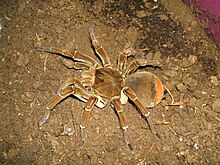229:
54:
33:
246:
can reach a length of 40 mm (1.6 in) and a width of 37 mm (1.5 in). The longest leg (the fourth) in a male had a total length of 110 mm (4.3 in). Coloration of these heavy-bodied spiders varies from rusty brown or rich burgundy-brown to dark brown, with reddish
279:
from its abdomen. These hairs are microbarbed and can cause irritation of the skin and when inhaled irritate the nose and throat. As last resort it will strike with its fangs. In captivity it feeds on any suitable sized invertebrates such as large
271:
burrows. It is a crepuscular and nocturnal species and it is quite defensive. When threatened this species will stridulate (hiss) to warn predators, it may also rear up and expose its
490:
451:
477:
554:
544:
482:
360:
495:
53:
272:
256:
252:
248:
243:
549:
391:
429:
521:
168:
228:
516:
344:
48:
267:
These tarantulas hide themselves in long tubes that they dig under the surface or use abandoned
503:
438:
508:
276:
538:
125:
443:
251:
on legs and abdomen and white lines on the legs. Adult males lack mating spurs or
275:. Another self-defence mechanism of this spider is to use its back legs to flick
464:
423:
281:
95:
32:
414:
145:
285:
197:
135:
85:
65:
408:
289:
105:
456:
314:
469:
268:
217:
213:
115:
75:
385:
389:
200:
398:
8:
354:
352:
309:
307:
305:
386:
359:Rudloff, J.-P. & Weinmann, D. (2010).
31:
20:
227:
301:
255:. Spiderlings and juveniles have pink
7:
340:
338:
361:"A new giant tarantula from Guyana"
14:
522:urn:lsid:nmbe.ch:spidersp:044496
259:on the front two pairs of legs.
52:
1:
325:, Natural History Museum Bern
220:, in tropical South America.
184:Rudloff & Weinmann, 2010
202:burgundy goliath bird eater
571:
555:Spiders described in 2010
174:
167:
49:Scientific classification
47:
39:
30:
23:
545:Spiders of South America
212:This species occurs in
235:
231:
323:World Spider Catalog
365:Arthropoda Scientia
236:
532:
531:
504:Open Tree of Life
430:Theraphosa stirmi
400:Theraphosa stirmi
392:Taxon identifiers
317:Theraphosa stirmi
240:Theraphosa stirmi
233:Theraphosa stirmi
193:Theraphosa stirmi
189:
188:
178:Theraphosa stirmi
42:Theraphosa stirmi
25:Theraphosa stirmi
16:Species of spider
562:
525:
524:
512:
511:
499:
498:
486:
485:
473:
472:
460:
459:
447:
446:
434:
433:
432:
419:
418:
417:
387:
380:
379:
377:
376:
356:
347:
345:Basic Tarantulas
342:
333:
332:
331:
330:
311:
277:urticating hairs
253:tibial apophyses
196:is a species of
180:
57:
56:
35:
21:
570:
569:
565:
564:
563:
561:
560:
559:
535:
534:
533:
528:
520:
515:
507:
502:
494:
489:
481:
476:
468:
463:
455:
450:
442:
437:
428:
427:
422:
413:
412:
407:
394:
384:
383:
374:
372:
358:
357:
350:
343:
336:
328:
326:
315:"Taxon details
313:
312:
303:
298:
265:
226:
210:
185:
182:
176:
163:
51:
17:
12:
11:
5:
568:
566:
558:
557:
552:
547:
537:
536:
530:
529:
527:
526:
513:
500:
487:
474:
461:
448:
435:
420:
404:
402:
396:
395:
390:
382:
381:
348:
334:
319:Rudloff, 2010"
300:
299:
297:
294:
264:
261:
225:
222:
209:
206:
187:
186:
183:
172:
171:
165:
164:
160:T. stirmi
157:
155:
151:
150:
143:
139:
138:
133:
129:
128:
123:
119:
118:
113:
109:
108:
103:
99:
98:
93:
89:
88:
83:
79:
78:
73:
69:
68:
63:
59:
58:
45:
44:
37:
36:
28:
27:
15:
13:
10:
9:
6:
4:
3:
2:
567:
556:
553:
551:
550:Theraphosidae
548:
546:
543:
542:
540:
523:
518:
514:
510:
505:
501:
497:
492:
488:
484:
479:
475:
471:
466:
462:
458:
453:
449:
445:
440:
436:
431:
425:
421:
416:
410:
406:
405:
403:
401:
397:
393:
388:
370:
366:
362:
355:
353:
349:
346:
341:
339:
335:
324:
320:
318:
310:
308:
306:
302:
295:
293:
291:
287:
283:
278:
274:
270:
262:
260:
258:
254:
250:
245:
241:
234:
230:
223:
221:
219:
215:
207:
205:
203:
199:
195:
194:
181:
179:
173:
170:
169:Binomial name
166:
162:
161:
156:
153:
152:
149:
148:
144:
141:
140:
137:
136:Theraphosidae
134:
131:
130:
127:
126:Mygalomorphae
124:
121:
120:
117:
114:
111:
110:
107:
104:
101:
100:
97:
94:
91:
90:
87:
84:
81:
80:
77:
74:
71:
70:
67:
64:
61:
60:
55:
50:
46:
43:
38:
34:
29:
26:
22:
19:
399:
373:. Retrieved
368:
364:
327:, retrieved
322:
316:
282:grasshoppers
266:
239:
237:
232:
211:
208:Distribution
201:
192:
191:
190:
177:
175:
159:
158:
146:
122:Infraorder:
41:
24:
18:
465:iNaturalist
424:Wikispecies
286:cockroaches
224:Description
96:Chelicerata
92:Subphylum:
539:Categories
375:2016-05-20
329:2016-05-20
296:References
147:Theraphosa
86:Arthropoda
40:Female of
198:tarantula
154:Species:
106:Arachnida
72:Kingdom:
66:Eukaryota
415:Q1995630
409:Wikidata
290:crickets
263:Behavior
244:carapace
132:Family:
82:Phylum:
76:Animalia
62:Domain:
509:5929932
496:1795669
483:1088651
457:8355178
371:: 21–40
142:Genus:
116:Araneae
112:Order:
102:Class:
470:628363
269:rodent
218:Brazil
214:Guyana
444:7C7D3
273:fangs
257:tarsi
249:setae
491:NCBI
478:ITIS
452:GBIF
288:and
242:the
216:and
517:WSC
439:CoL
238:In
541::
519::
506::
493::
480::
467::
454::
441::
426::
411::
367:.
363:.
351:^
337:^
321:,
304:^
292:.
284:,
204:.
378:.
369:1
Text is available under the Creative Commons Attribution-ShareAlike License. Additional terms may apply.

